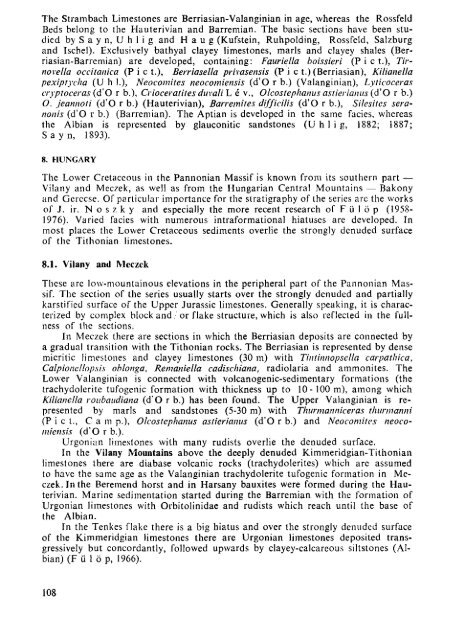THE MEDITERRANEAN LOWER CRETACEOUS
THE MEDITERRANEAN LOWER CRETACEOUS
THE MEDITERRANEAN LOWER CRETACEOUS
Create successful ePaper yourself
Turn your PDF publications into a flip-book with our unique Google optimized e-Paper software.
The Strambach Limestones are Berriasian-Valanginian in age, whereas the Rossfeld<br />
Beds belong to the Hauterivian and Barremian. The basic sections have been studied<br />
by S a y n, U h 1 i g and H a u g (Kufstein, Ruhpolding, RossFeld, Salzburg<br />
and Ischel). Exclusively bathyal clayey limestones, marls and clayey shales (Berriasian-Barremian)<br />
are developed, containing: Fauriella boissieri (P i с t.), Tirnovella<br />
occitanica (P i с t.), Berriasella privasensis (P i с t.) (Berriasian), Kilianella<br />
pexiptycha (U h 1.), Neocomites neocomiensis (d'O r b.) (Valanginian), Lyticoceras<br />
cryptoceras (d'O г b.), Crioceratites duvali h é v., Olcostephanus astierianus (d'O r b.)<br />
O. jeannoti (d'O r b.) (Hauterivian), Barremites difficilis (d'O r b.), Silesites seranonis<br />
(d'O r b.) (Barremian). The Aptian is developed in the same facies, whereas<br />
the Albian is represented by glauconitic sandstones (U h 1 i g, 1882; 1887;<br />
Sayn, 1893).<br />
8. HUNGARY<br />
The Lower Cretaceous in the Pannonian Massif is known from its southern part —•<br />
Vilany and Meczek, as well as from the Hungarian Central Mountains — Bakony<br />
and Geiccse. Of particular importance for the stratigraphy of the series are the works<br />
of J. ir. N о s z к у and especially the more recent research of F ii I о p (1958-<br />
1976). Varied facies with numerous intraformational hiatuses are developed. In<br />
most places the Lower Cretaceous sediments overlie the strongly denuded surface<br />
of the Tithonian limestones.<br />
8.1. Vilany and Meczek<br />
These arc low-mountainous elevations in the peripheral part of the Pannonian Massif.<br />
The section of the series usually starts over the strongly denuded and partially<br />
karstificd surface of the Upper Jurassic limestones. Generally speaking, it is characterized<br />
by complex block and. or flake structure, which is also reflected in the fullness<br />
of the sections.<br />
In Meczek there are sections in which the Berriasian deposits are connected by<br />
a gradual transition with the Tithonian rocks. The Berriasian is represented by dense<br />
micritic limestones and clayey limestones (30 m) with Tintinnopsella carpathica,<br />
Calpionellopsis oblonga, Remaniella cadischiana, radiolaria and ammonites. The<br />
Lower Valanginian is connected with volcanogenic-sedimentary formations (the<br />
trachydolerite tufogenic formation with thickness up to 10- 100 m), among which<br />
Kilianella roubaudiana (d'O r b.) has been found. The Upper Valanginian is represented<br />
by marls and sandstones (5-30 m) with Thurmanniceras thurmanni<br />
(P i с t., С a m p.), Olcostephanus astierianus (d'O r b.) and Neocomites neocomiensis<br />
(d'O r b.).<br />
Urgonian limestones with many rudists overlie the denuded surface.<br />
In the Vilany Mountains above the deeply denuded Kimmeridgian-Tilhonian<br />
limestones there are diabase volcanic rocks (trachydolerites) which arc assumed<br />
to have the same age as the Valanginian trachydolerite tufogenic formation in Meczek.<br />
In the Beremend horst and in Harsany bauxites were formed during the Hauterivian.<br />
Marine sedimentation started during the Barremian with the formation of<br />
Urgonian limestones with Orbitolinidae and rudists which reach until the base of<br />
the Albian.<br />
In the Tenkes flake there is a big hiatus and over the strongly denuded surface<br />
of the Kimmeridgian limestones there are Urgonian limestones deposited transgressively<br />
but concordantly, followed upwards by clayey-calcareous siltstones (Albian)<br />
(F u 1 ô p, 1966).<br />
108

















